A few weeks back, Frank Walton RDP, was kind enough to alert me to the sale of his six-volume The De La Rue Collection (2014) at an Australian auction house – Abacus Auctions; he knew that I have been searching for the set. While I had placed an alarm to wake myself up early that Monday morning, the 31st of August, I cancelled it the previous night when I realised that the price had already gone beyond my budget!
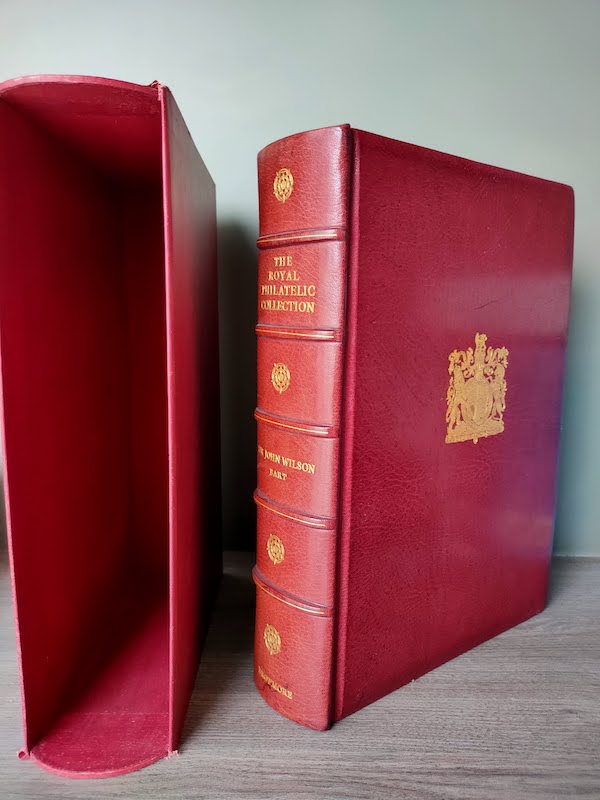
Next day, checking the prices realised, I saw that the next immediate lot was The Royal Philatelic Collection by Sir John Wilson (Figures 1 and 2). Published in late 1952 and winner of The Crawford Medal in 1953, this is the most luxurious and beautiful philatelic book of all time. What left me in astonishment was the realisation – A$ 4312.80 (approximately USD 3,140 or GBP 2,190 at the time of writing this) including buyer’s premium of 19.80%! This price stuck me as being absolutely ridiculous as anyone with basic Google search skills can find out for him/herself.
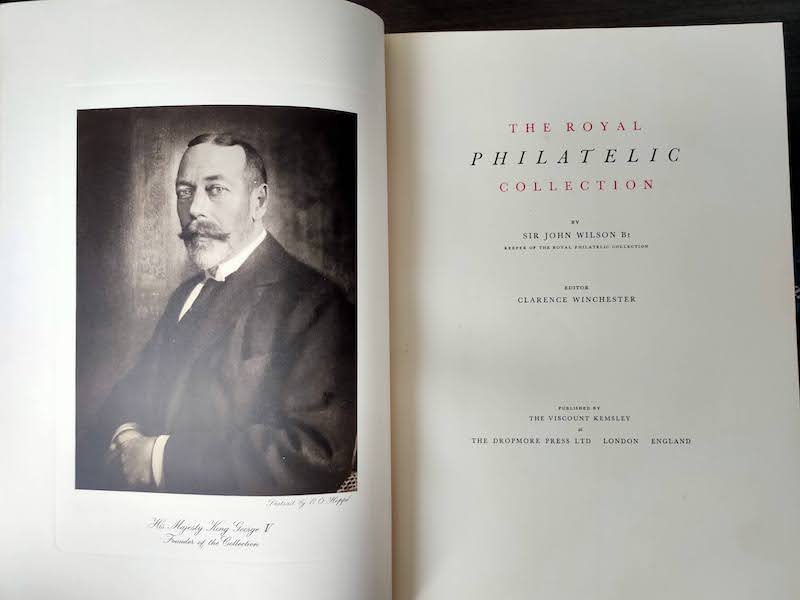
Background
The Royal Philatelic Collection was edited by Clarence Winchester and authored by Sir John Wilson, Keeper of the Royal Philatelic Collection from 1938 to 1969 as well as the President of The Royal Philatelic Society London from 1934 to 1940 and again from 1949 to 1950. At that time the Royal Collection consisted of 330 large albums containing a total of nearly a quarter million of stamps.
According to Sir John Wilson, it was King George VI who wanted the book to be published and hence it was to him that it was dedicated. The King always wanted, as far as was practical, to share what he had with his people. And since one “can’t allow the whole of Great Britain to come into Buckingham Palace and inspect the collection”, the King allowed his most valuable and interesting stamps to be printed in this volume.
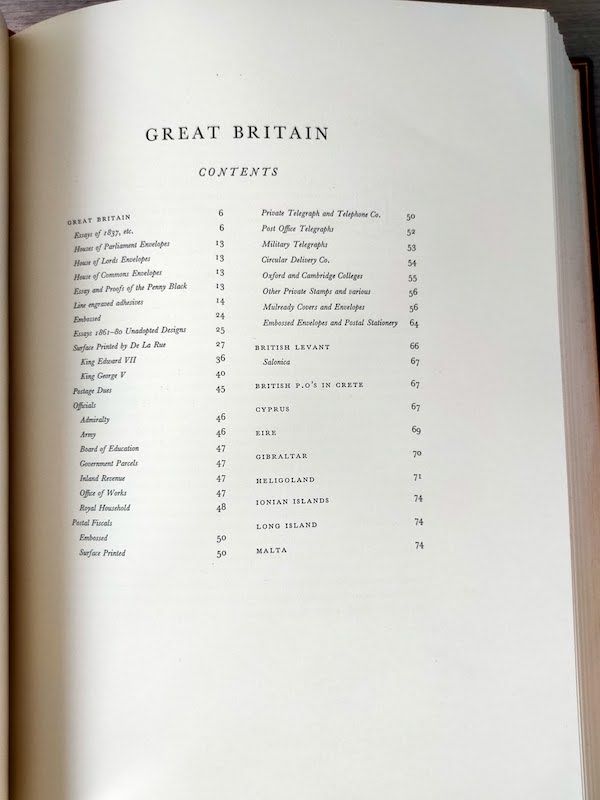
Lord Kemsley, owner of The Dropmore Press, undertook the task of publishing the book. Lord Kemsley was a Welsh colliery owner and newspaper tycoon who owned, amongst others, The Sunday Times. Much effort was involved in its production as the publisher wanted to uphold to the highest standards of book production viz. a binding designed to last for centuries, full thickness red Nigerian Morocco leather covering the boards (one whole goat skin being required for each volume) and stamped in gold with the Royal Coat of Arms on the front and the Tudor rose motif on the back covers, and precise colour photo-lithography using 51 machinings when printers at this time had no experience with more than 25 colours.
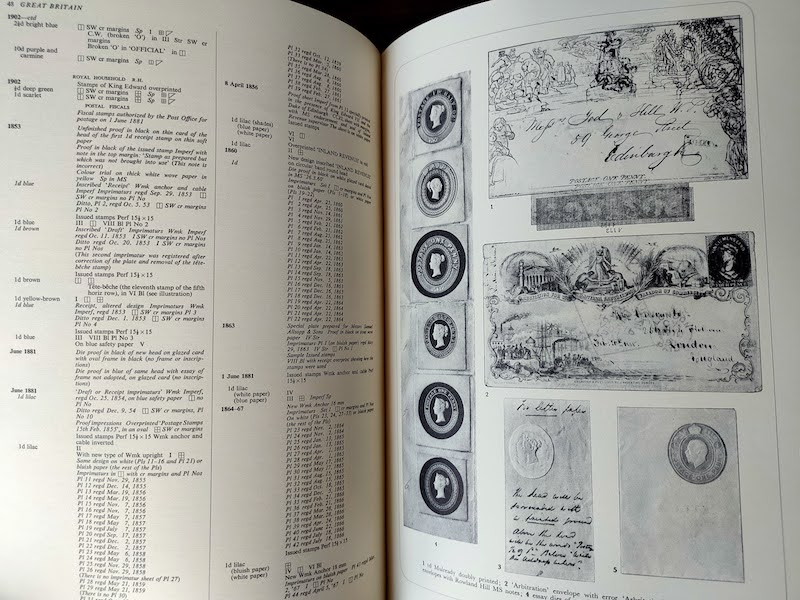
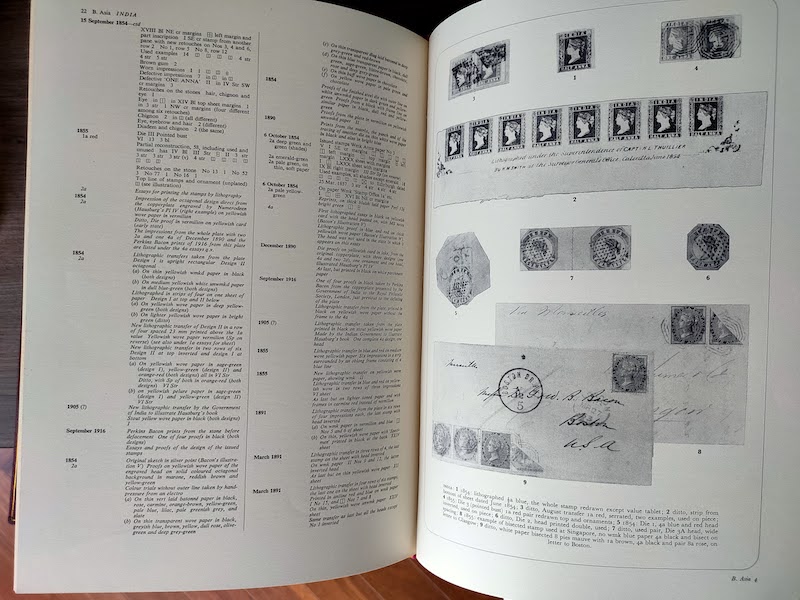

The book consists of two parts: (a) introduction narrating the story of the royal collection followed by the (b) catalogue of the collection. The first part is printed on thick coated while the second is printed on thick uncoated paper. The catalogue comprises of five sections for Great Britain, British America, British Africa, British Asia, and British Australasia.
There are 12 colour (depicting stamps and each protected by onionskin paper (Figure 6); printed on one side only) and 16 monochrome plates (depicting albums, housing of the collection, and various album pages; printed on both sides) in the introduction part apart from two photographs of King George V and King George VI as frontispiece. The catalogue part contains 48 monochrome plates of stamps and covers (Note 1).
The “dog” moniker
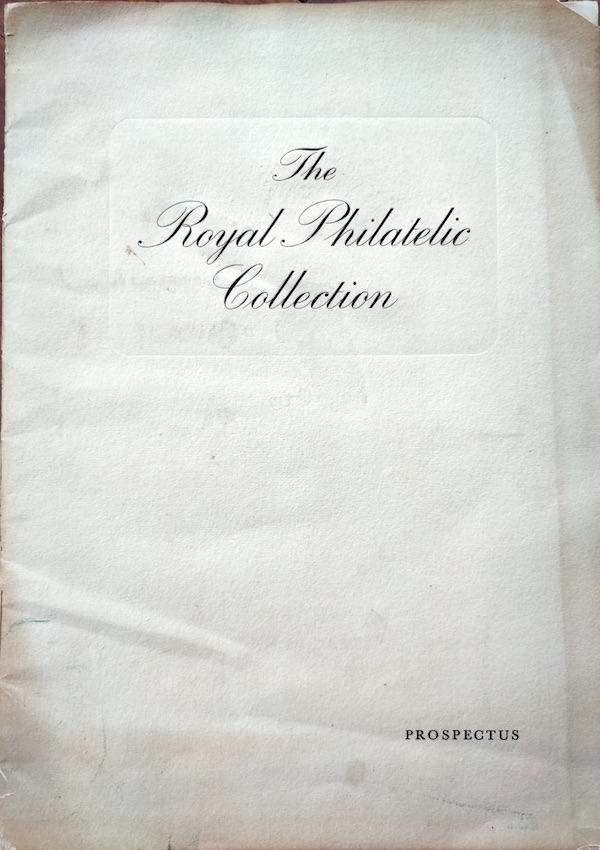
The superb production values of the book came with its downside of high cost. Originally expected to be priced at 20 guineas (£21), the cost of the book went up to 60 guineas (£63) or US$180 when published in 1952. This equates to £1,825 in today’s money. Clearly beyond most people given that the average weekly wage levels in Britain in the 1950s was just about £7.
To market the book, a prospectus (containing 12 pp plus one colour and two monochrome plates) was issued. Agents were appointed to sell the book inside and outside the UK. Further, the publishers were aware of the cost factor and devised instalment plans. Robson offered three plans while The British Book Centre in US offered one (though it is curious that they did not give any discount for the full cash order).

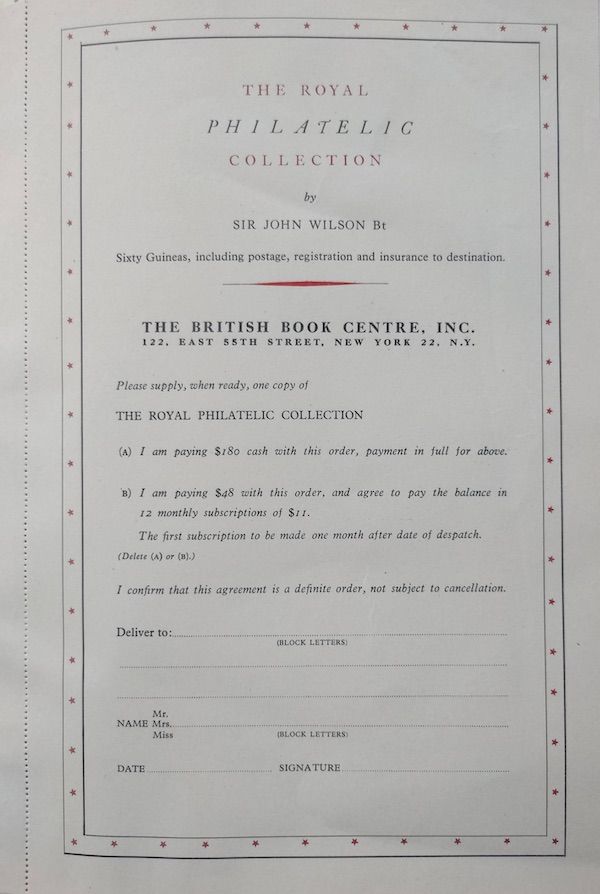

Dog: People use dog to refer to something that they consider unsatisfactory or of poor quality. [US, informal, disapproval]
Over time, the book became, as William Hagan puts it, “a dog on the market”. Of the edition of 3,000 copies (4,000 as per a knowledgeable English editor; the difference in printing numbers may have been due to printing waste being included in the latter number), 1,500 copies were bound in leather and the remaining sheets were stored flat. Despite hard marketing, the bound copies did not sell well and the price of the book dropped to £30 in England and $85 in the US by the mid-1960s. In 1975 Bridger & Kay was selling a new unpacked book for £85 (Note 2).

By 1955, Dropmore Press had gone bankrupt. There was no interest in the remaining copies, which had remained flat and unbound, due to their poor sales record. Finally, in 1963, 1,000 of the unbound pages of the catalogue part were acquired by Stamp Collecting Ltd (Note 3); the remaining being destroyed. The catalogue was divided into five separate books to comply with the stipulation that they be different from the original 1,500. Kenneth F. Chapman, the then editor of Stamp Collecting, added his own comments to each section (Note 4). They were divided up and priced as follows:
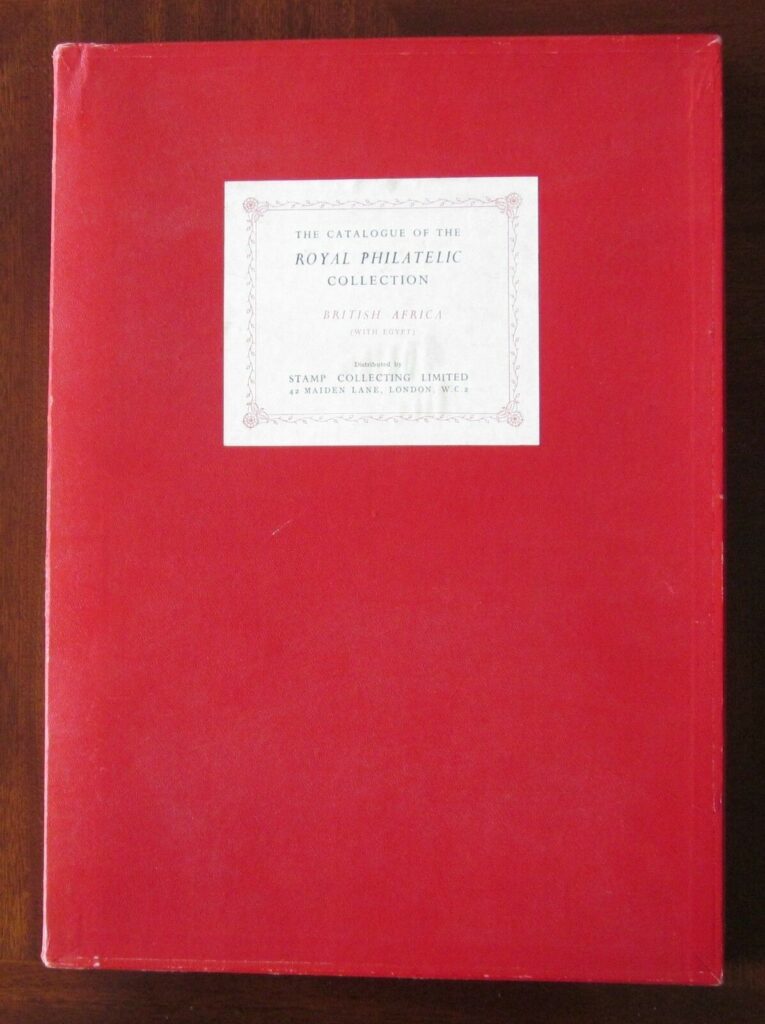
- Section 1: Great Britain (74 pp, 1 colour & 16, monotone plates) – £10
- Section 2: British America (48 pp, 3 colour & 8 monotone plates) – £5
- Section 3: British Africa (63 pp, 2 colour & 8 monotone plates) – £5
- Section 4: British Asia (62 pp, 1 colour & 8 monotone plates) – £5
- Section 5: British Australasia (75 pp, 2 colour & 8 monotone plates) – £5
In the US, Section 1 sold for US$28 and the others for US$14 each.
In Volume 2 of his magnum opus, Philatelic Literature A History and a Select Bibliography From 1861 to 1999, Dr. Manfred Amrhein tells a story of seeing the book in 1965 at the Weill Brothers “Rare Stamp Shop” in New Orleans but not being able to afford it. He sounds a warning note familiar to most publishers of philatelic books:
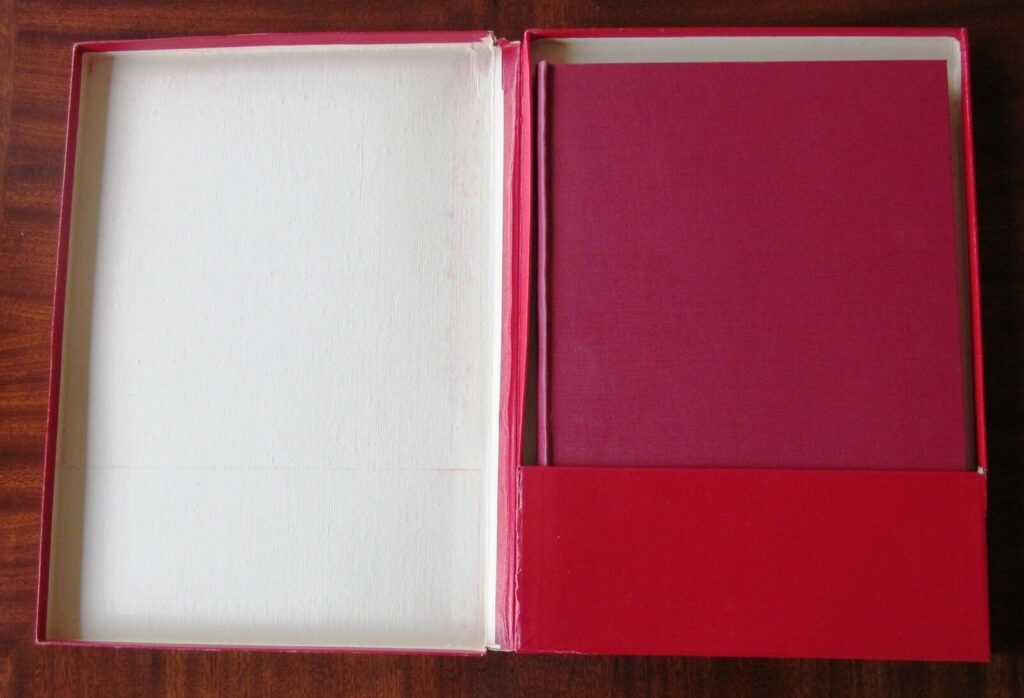
The story of The Royal Philatelic Collection confirms that no matter how good the research, how scholarly the prose, or how luxurious the production, most philatelic works, aside from the yearly published catalogues, rarely sell in a quantity to be a commercial success.
Other Versions
Apart from the original leather bound edition and the individual sections of Stamp Collecting, a red cloth bound version exists. I am not sure of its genesis but it may have been brought out by the publishers as a low-cost alternative (Note 5). Limited numbers must have been published since it seems to be scarcer than the leather bound version.
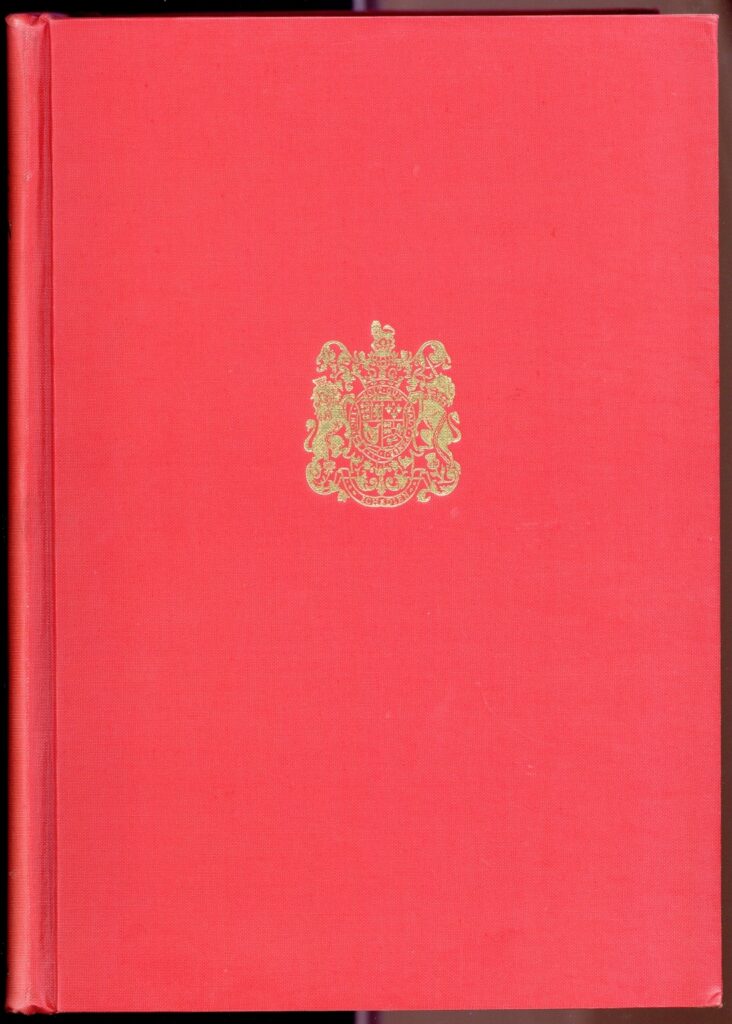
As an aside, both the leather and the cloth bound editions are housed in a red cloth-covered wooden slipcase. The slipcase is not strong enough to house such a heavy book and hence most slipcases have associated wear and tear.
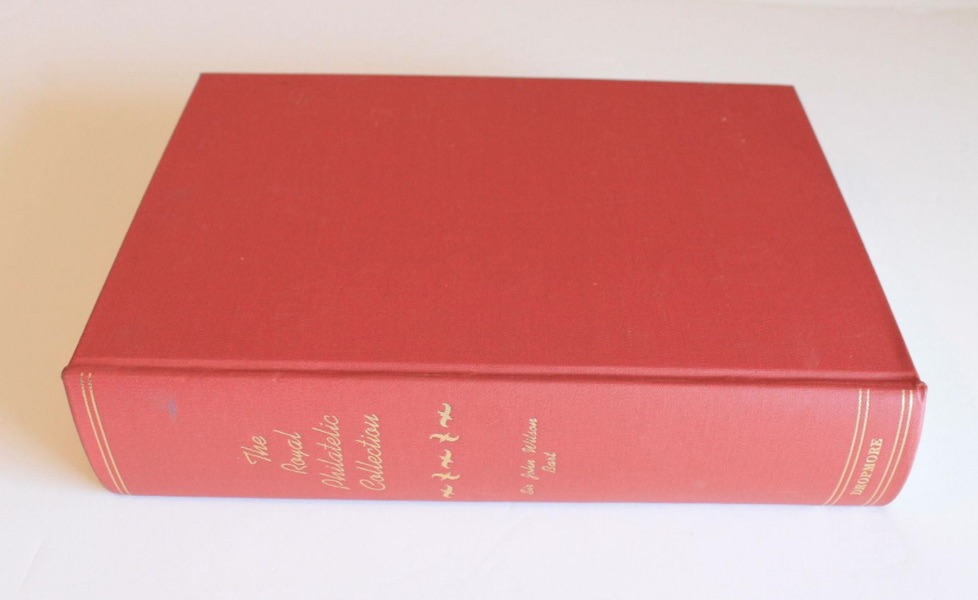
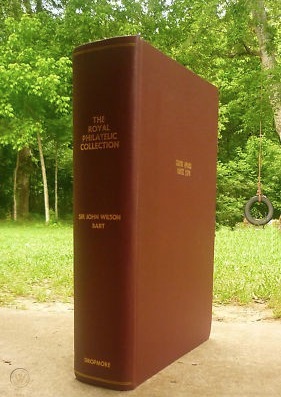
Hagan also records a few books bound in grey cloth. Their origin is not known and I have never seen one. Hagan also records the book’s appearance as a catalogue without the introduction. In this form, some 20 plates and 98 pages are omitted; the colour plates are included though. Finally, there exists some copies which seem to have been privately bound.
Prices
Two copies sold in Prestige Auctions (another Australian auction house now taken over by Abacus) on 14 November 2014 for A$ 2,574 and A$ 2,808 including buyer’s premium (lots 923 and 924). High prices are not just confined to Australia though. Another two copies were sold in Heinrich Köhler’s special literature auction held on 3 November 2012, to coincide with the International Philatelic Literature Exhibition (IPHLA) in Mainz, for EUR 1,428 each including buyer’s premium (lot numbers 9306 and 9307). In a Cavendish auction sale on 4 March 2020, a copy sold for £1,920 including buyer’s premium of 20%; but the main attraction of this lot (number 213) were the accompanying ephemera viz. contemporary press photographs for the publication of the book, the prospectus and advanced publicity booklets, letters to and from Clarence Winchester (including from Buckingham Palace and some framed behind glass), and two menus from a dinner held to celebrate the publication.
Apart from these realisations, I have recently not seen copies going for such high prices. In fact I agree with Hagan; there are just too many of them available for sale at any point in time and hence the overhang will always reflect on the price. A simple internet search leads to copies selling for anywhere between 10% and 25% of these prices! Further, most copies are in a great condition given that, physically, it is not an easy book to handle and most of them have hardly been used.
In parting
Due to the democratisation of information thanks to the internet, many items, hitherto expensive, are available cheaper than ever before. So one wonders: why do people buy easy-to-find stuff at unjustifiably high prices? Do they not have the time or the thought to check ongoing rates? Or is it that some do not know how to do this? Whatever be the reason, this is not the first or the last time people are literally giving away their good money.
Meanwhile, sellers may do well to consign this book in particular to auction houses rather than sell them privately. After all, every dog has its day!
Notes
Note 1: I have seen listings on eBay wherein cutouts of stamps from these plates are being sold for obscene prices. Perhaps the sellers are trying to do what was done to the Fournier and Sperati albums; but the latter are actual stamps albeit forgeries whereas the ones in the plates are just prints. I do hope these cutouts are from the unbound pages and bound books are not been ransacked this way.
Note 2: I bought my copy from them in 2013; perhaps one of their last available copies, they were happy to sell it at a fraction of recent auction prices.
Note 3: Both Hagan and Amrhein mention incorrectly that the remainders were bought over by the owners of The Stamp Lover.
Note 4: The five individual sections sold at an Corinphila Auction No. 227 held 26 November 2018 (Lot 1765) for CHF 360 exclusive of buyer’s premium.
Note 5: Update on 8 Sep 2020: Within an hour of this blog being published, Rudolf Buschhaus of Germany emailed me with more information. He thinks that the cloth bound version is likely to have been published first and may have been for libraries. In his copy is an error on page 29 wherein Plate 12 is mentioned (line 14 from top) instead of Plate II and a page correcting this error to Plate II is laid in. According to Jan Vellakoop, Plate II is itself an error and it should be Plate XI (see comments below). I think that while plates have Roman numerals on them, they are referred to in the text using Arabic numbers; for example page 27 refers to Plates One and Two using Arabic numbers (I and II). Hence the corrected page 29 line 14 is actually a ‘eleven’ (II).



Note 6: Update on 9 Sep 2020: Rudolf has drawn my attention to articles and letters to the Editor which appeared in 2/2014 and 3/2014 issues of Wolfgang Maassen’s Phila Historica; I was not aware of them. One interesting information that Maassen gives is that the cost of the 12 colour plates alone worked out to £12,000 and of the entire project upwards of £100,000. The rest of the information is based on inquiries made by Rainer Fuchs with The Royal Philatelic Society London. Howard Summers and later Rainer Fuchs sent me a copy of the letter that the RPSL sent to Fuchs. The reader will note that some of the information is contradictory to what may be found elsewhere in the blog; at this time, I would go with Hagan’s information since that is more contemporary.
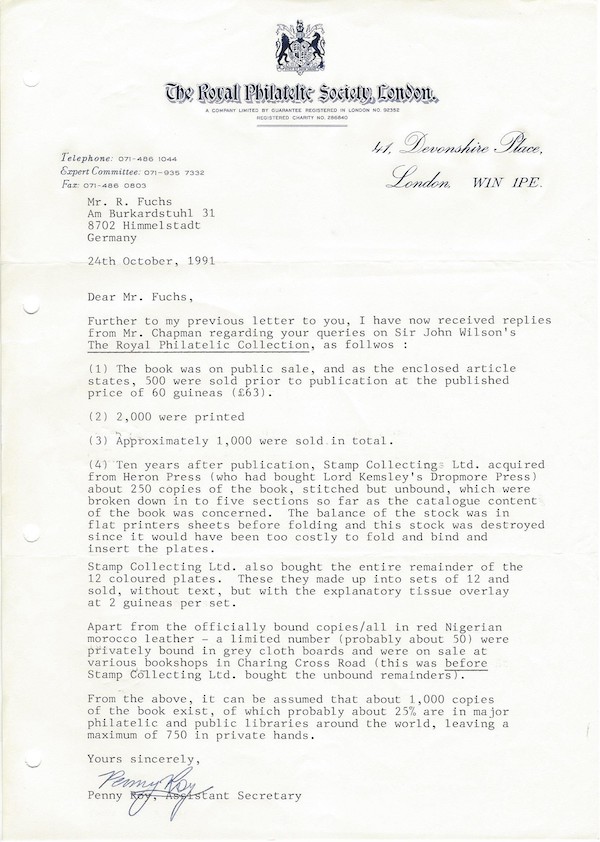
Courtesy: Rainer Fuchs.
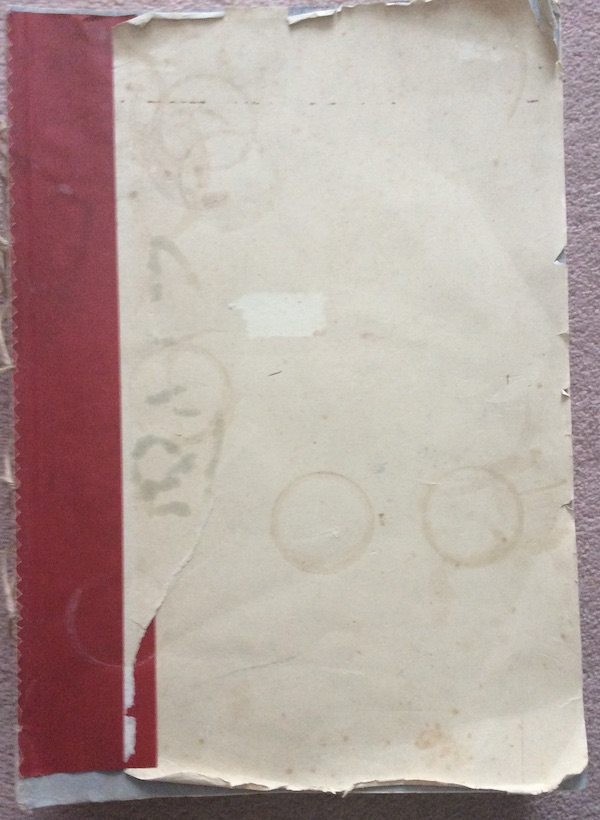
Note 7: Update on 9 Sep 2020: Howard Summars has also sent some photos of his book in a disbound state. Wonder if it is an example from the pre-production period in the 1950s? The details of the book are as follows:
Size 375 x 265 mm (the usual pages are 357 x 255 mm)
Pages are uncut with no gilt on the top edge
Page 29 Line 14 has ‘II’ and not ’12’
The copyright line on the dedication page opposite King George VI’s photo does not exist

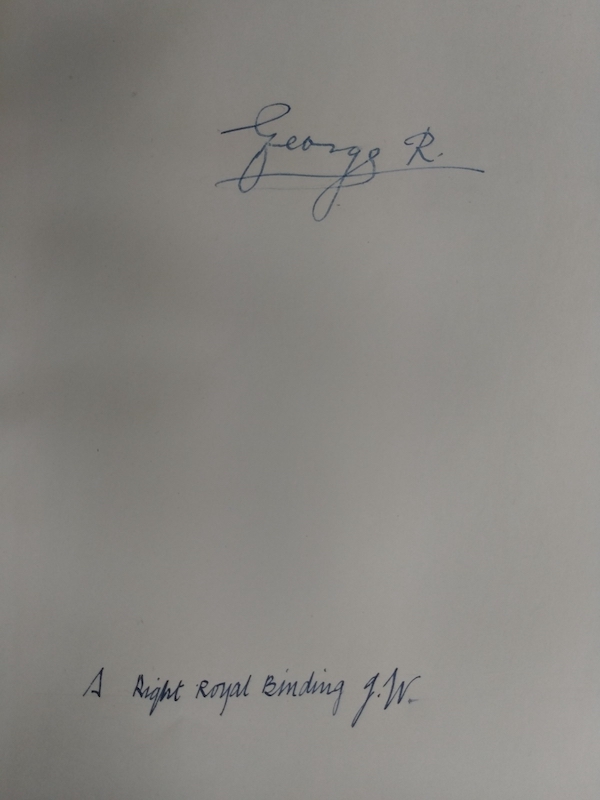
Note 8: Update on 2 Oct 2020: In today’s auction by Argyll Etkin, lot 618 containing a King George VI signed copy was sold for £3,300 plus buyer’s premium. According to the description, since the King died on 6 February 1952, the year the book was published, this copy is probably a early proof edition. It is also inscribed “A Right Royal Binding JW” and signed by Sir John Wilson. The auction company informed me that it was in the collection of the previous owner for 30 years. I fancied a bid but when the lot opened at £1,800 I closed my live bidding window!
References
- Amrhein, Manfred. Philatelic Literature: A History and a Select Bibliography from 1861 to 1991 Volume 2. Vol. 2. 4 vols. San Jose, Costa Rica: The Author, 1997
- Birch, Brian J. The Philatelic Bibliophile’s Companion. Montignac Toupinerie, France: The Author, 2020
- Hagan, William. “Philatelic Literature Price Trends.” Philatelic Literature Review Vol. 28 No. 1 Whole No. 102 (First Quarter 1979): 29-33
- Holmes, H. R. “King Georve V and his Stamp Collection.” The London Philatelist Vol. LXII Whole No. 723 (February 1953): 21-23
- https://stampboards.com/viewtopic.php?f=13&t=24199. Accessed on 7 September 2020. Note that some of the posts on this thread are mine.
- Maassen, Wolfgang. Sir John Wilson: The Royal Philatelic Collection. Phila Historica Nr. 2 July 2014: 157-161.
- Letters to Editor from Jan Vellekoop, Frank Walton, and Federico Borromeo all published in Phila Historica Nr. 2 October 2014: 5-10


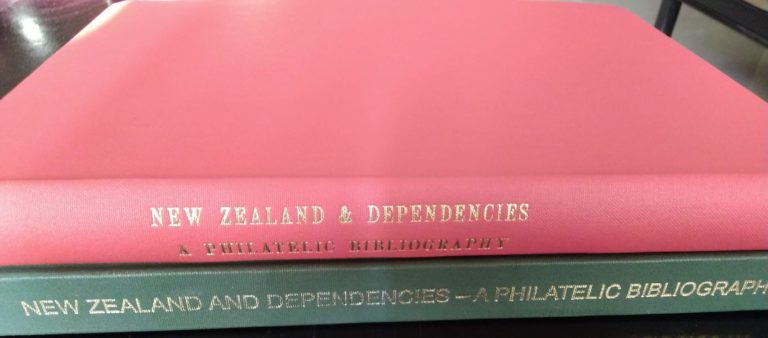




Thank you, Abhishek, for this excellent overview!
Hello Abhishek,
I own two copies of the book. One is the leather edition in its broken slipcase. (My wife calls it “The Goat Book !”.) The other copy I found on eBay. It is the complete volume with plates without a cover and tied with string. It is uncut on its edges and is slightly larger then the published version. Anyone know what it is? As you state the unsold copies were separated and only the catalogue was used. I can email you pictures.
Great article as usual.
Hi Howard,
Thanks for your appreciation. Your pages could be ex-Dropmore Press (from their stock of 1,500 left unbound) or ex-Stamp Collecting (of the 1,000 which the latter purchased from Dropmore, there is a good chance they did not bind all of them into the individual sections).
Please do send me an email with the photos. My email address is on my About Me page.
Best Regards
many tks.Abhishek. a very detailed and useful information! Well done! will publish it in my website http://www.philatelymuseum.com soon. b.rgds.Jack
Most useful start of a further discussion of this monument of philatelic literature.
I do not believe however that the cloth version was published first (note 5) and that it was destined especially for libraries. It would have been announced as such in the contemporary philatelic press, something I never noticed. Most institutional philatelic libraries that I visited hold a copy in full red Niger morocco.
In my own two copies (a Red Niger version and a red cloth version without any title or crest on the binding) page 29, line 14 refers (wrongly) to Plate “II” [Roman numerals], which should have read Plate “XI”. I would love to see a picture of this page referring to a plate “12” [Arabic numerals].
Regards to all,
Jan Vellekoop
Dear Abhishek, dear Jan,
I’m sending Abhishek pictures of the corresponding places on p. 29. Maybe he can show them here. In my clothbound edition, the paper is partially scraped off at the plate number. In the enlargement you can clearly see that there was an Arabic “2”.
Probably the first owner of the book requested a replacement page from the publisher.
Therefore it seems plausible to me that the cloth edition was bound first.
Best regards to all bibliophiles
Rudolf
Dear Abhishek, great article. I own two copies of the book, one I purchased in Baghdad in 1990; but this is another story.
I also have the pamphlets which were produced to advertise these book; will send scans of these as well and you may add them. Give me a few days…